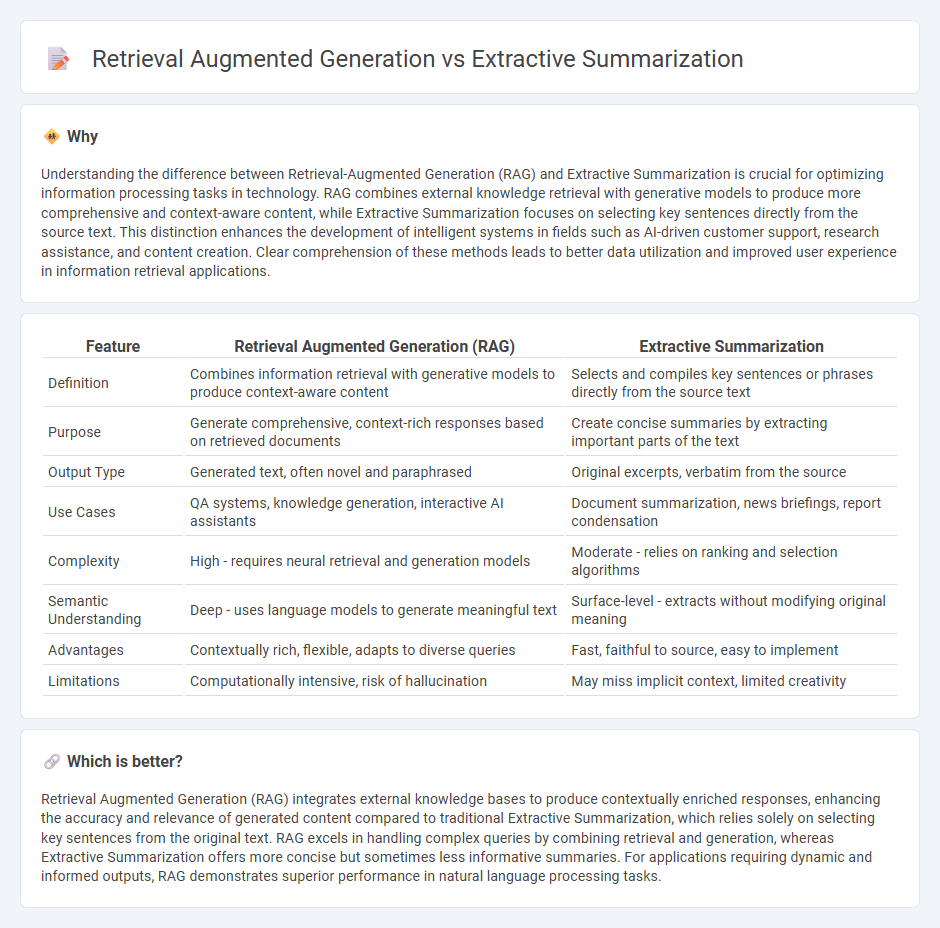
Retrieval Augmented Generation (RAG) leverages external knowledge bases to generate contextually rich and informative responses, enhancing the relevance and accuracy of AI outputs. Extractive summarization focuses on selecting key sentences or phrases directly from the source text, preserving the original content without generating new language. Explore the distinctive benefits of RAG and extractive summarization to understand their applications in natural language processing.
Why it is important
Understanding the difference between Retrieval-Augmented Generation (RAG) and Extractive Summarization is crucial for optimizing information processing tasks in technology. RAG combines external knowledge retrieval with generative models to produce more comprehensive and context-aware content, while Extractive Summarization focuses on selecting key sentences directly from the source text. This distinction enhances the development of intelligent systems in fields such as AI-driven customer support, research assistance, and content creation. Clear comprehension of these methods leads to better data utilization and improved user experience in information retrieval applications.
Comparison Table
| Feature | Retrieval Augmented Generation (RAG) | Extractive Summarization |
|---|---|---|
| Definition | Combines information retrieval with generative models to produce context-aware content | Selects and compiles key sentences or phrases directly from the source text |
| Purpose | Generate comprehensive, context-rich responses based on retrieved documents | Create concise summaries by extracting important parts of the text |
| Output Type | Generated text, often novel and paraphrased | Original excerpts, verbatim from the source |
| Use Cases | QA systems, knowledge generation, interactive AI assistants | Document summarization, news briefings, report condensation |
| Complexity | High - requires neural retrieval and generation models | Moderate - relies on ranking and selection algorithms |
| Semantic Understanding | Deep - uses language models to generate meaningful text | Surface-level - extracts without modifying original meaning |
| Advantages | Contextually rich, flexible, adapts to diverse queries | Fast, faithful to source, easy to implement |
| Limitations | Computationally intensive, risk of hallucination | May miss implicit context, limited creativity |
Which is better?
Retrieval Augmented Generation (RAG) integrates external knowledge bases to produce contextually enriched responses, enhancing the accuracy and relevance of generated content compared to traditional Extractive Summarization, which relies solely on selecting key sentences from the original text. RAG excels in handling complex queries by combining retrieval and generation, whereas Extractive Summarization offers more concise but sometimes less informative summaries. For applications requiring dynamic and informed outputs, RAG demonstrates superior performance in natural language processing tasks.
Connection
Retrieval augmented generation (RAG) enhances natural language understanding by integrating external information retrieval with generative models, allowing for more accurate and context-aware content creation. Extractive summarization complements RAG by identifying and extracting key sentences from retrieved documents to form concise summaries, improving information relevance and coherence. Both techniques leverage document retrieval to optimize information extraction and generation in artificial intelligence applications.
Key Terms
Sentence Selection (Extractive Summarization)
Sentence selection in extractive summarization involves identifying and extracting the most relevant sentences directly from the source text to create a concise summary. This method relies on algorithms that score sentences based on features like relevance, frequency, and position to ensure key information is preserved without altering the original wording. Explore the latest advancements in sentence selection techniques to enhance extractive summarization performance.
Knowledge Retrieval (Retrieval Augmented Generation)
Extractive summarization selects key sentences or phrases directly from the source text to generate concise summaries without altering the original content. Retrieval Augmented Generation (RAG) enhances knowledge retrieval by integrating external databases or documents into the generation process, enabling more accurate and context-rich responses beyond the input text. Explore how RAG leverages advanced retrieval mechanisms to improve information relevance and generation quality.
Language Generation (Retrieval Augmented Generation)
Extractive summarization selects and compiles key sentences directly from source texts, maintaining original phrasing but limiting the generation of new content. Retrieval Augmented Generation (RAG) enhances language models by incorporating external knowledge retrieval, allowing the generation of contextually rich and accurate responses that go beyond the initial input. Explore the advances in RAG techniques to understand their superior capabilities in producing dynamic and informed language outputs.
Source and External Links
Text Summarization Techniques - GeeksforGeeks - Extractive summarization identifies and extracts primary sentences or phrases from the original text to create a concise summary, using techniques like TF-IDF and Latent Semantic Analysis to evaluate sentence importance based on statistical and semantic measures.
What is text summarization? - IBM - Extractive summarization condenses documents by selecting and combining unmodified sentences from the original text, often scored for importance to reduce redundancy, and can operate with or without neural network models like transformers.
Extractive Summarization with LLM using BERT | Exxact Blog - Extractive summarization uses language models like BERT to parse text into sentences, extract features such as keyword frequency and sentence position, and then select key sentences for inclusion in the summary based on these features.
 dowidth.com
dowidth.com